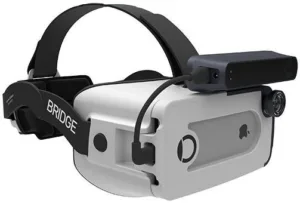The original charter of Occipital Inc. (Boulder, CO and San Francisco, CA) was to develop state-of-the-art mobile computer vision applications. About three years ago, the company released a hardware product, a depth-sensing device called the Structure Sensor. Building on these technologies, the company has now debuted a product called Bridge, a mixed reality headset based on an iPhone. One of the principle claims made by the company for Bridge is that, “unlike some high-end VR devices that require a gaming PC, Bridge is mobile and can render mixed reality experiences at high frame rates and low latency on current generation mobile devices.”
The Bridge is specifically for iPhones 6/6s and 7 running at least operating system iOS 9. The headset is designed such that the iPhone is held in the frame of the device by a magnetically latched door. The headset itself is reported to be well balanced and held in place on the user’s head by an adjustable headband. At the moment, the lenses in the headset have been described as sitting a little closer to the user’s eyes than desirable, sometimes pushing against the user’s glasses. Apparently this issue will be resolved in a future model of the headset.
The headset attaches a PMMA optical grade acrylic lens to the back camera lens of the iPhone. This lens serves to double the iPhone’s field of view to 120 degrees.
The Structure Sensor has a sensing range of over 3.5 meters and can produce a depth map that updates at 30fps. In addition, the Structure Sensor enables 6-DoF inside-out positional tracking. No external cameras or fiducial markers are required. In addition, all calculations are done in the iPhone and, thus, no computer is needed. The net result is that the system runs in real time completely “on-device” and the user is free to physically move about within their environment.
The Bridge Engine appears to efficiently synthesize data from the Structure Sensor’s depth sensing system and the iPhone’s color camera and IMU (Internal Measurement Unit) to realistically merge virtual content and characters with real world environments to deliver the mixed reality experience. The virtual content is reported to look “like it actually exists in the real world. This includes obeying the laws of physics, casting shadows and visual interactions like occlusion.”
The Bridge Engine uses view dependent rendering to create a unique image for each eye. This enable stereo vision that extends to the near periphery of the field of view.
A dedicated “Wii remote-like” Bluetooth Controller that comes with the Bridge headset also enables 3DOF rotational tracking and, thus, the ability to manipulate virtual objects with high precision. With five buttons and an onboard IMU, the controller is claimed to it make interactions seem both smooth and natural.
The headset is illustrated in the figure below and in the video appended to the end of this article.
Other headset system specifications include the following:
- Resolution – 326 PPI
- Refresh rate – 60fps
- Camera input to fully tracked pose time – 10ms
Bridge is compatible with existing iOS VR applications and 360-degree content, including movies.
Occipital does not have any launch titles planned for the Bridge’s debut, but it does come with a demo app called Bridget. The little robot in this AI app can learn and interact with the surrounding world and it can be trained via the Bridge Engine. Using the controller, one user described the ability to toss a virtual ball around an office and watch Bridget loop around coffee tables to retrieve it.
At this time, early adopters can obtain a Bridge “Explorer Edition” package for $499. The Bridge will go one sale to the general public for $399 starting in March. -Arthur Berman
Occipital Inc., Adam Rodnitzky, 415-816-5719, [email protected]

